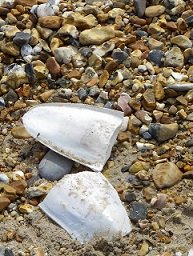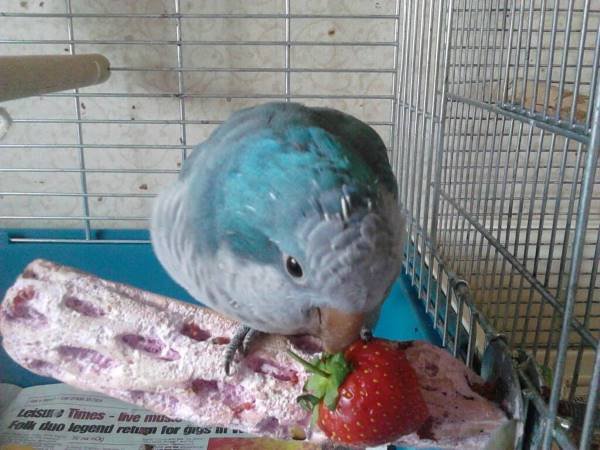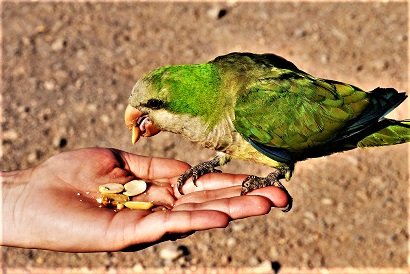In this article, we will talk about the Quaker parrots, and do they need cuttlebone in their diet? What are the main ingredients of the cuttlebone and how it helps our pet?
Cuttle Bone is necessary for Parrot’s diet, as its main source of calcium that is used in the Quaker parrot body to build bones. It is also a rich source of other minerals like potassium, and iron. It is especially important if you are not using too many vegetables in your parrot diet. Cuttlebone, together with a balanced diet full of vitamins is necessary for Quaker parrot Health.
The Normal Diet of Quaker Parrots:
Quaker parrot originates from Argentina, South America. Quaker parrots often eat chopped dark green and yellow veggies. They also eat a variety of fruits and grated cheese. They love to eat hard-cooked eggs, in addition to this, they also need some amount of calcium for their body. Cuttlebone is the best option as it is a rich source of calcium for Quaker parrots.
What is Cuttlebone?
The internal shell of the Cuttlefish is called cuttlebone. It is not a bone but rather the inner shell of the Cuttlefish. When the fish eats a meal, then the cuttlebone is formed inside. Many captive birds like Quaker parrots need cuttlebone in their diet. It is the best supplement with which they can grind their beaks.
Cuttlebone is very helpful for the Cuttlefish to control the buoyancy in water. Cuttlebone is filled with gases. People use cuttlebone for many purposes as it is a great supplement and exercise tool for birds.

Composition of Cuttlebone
There is an 85% calcium present in the cuttlebone. So, it is an ideal source of calcium for the birds to increase their calcium level to a much greater extent. Another significant component is present in the cuttlebone, which is called organic material. It makes up about 8.9% of that organic material and is called carbohydrate material.

Cuttlebone for Quaker Parrots
When you feed the Quaker parrots with cuttlebone then where it is a good source of protein, it can also be a good source of calcium. When the parrot starts cracking the bone, it is eating calcium. Parrots love to eat the marrow out of it.
Cuttlebone is a Good Source of Calcium
Cuttlebone is a good source of calcium, but there is a problem with Quaker parrots that without all the proper vitamins, minerals, and sunlight, they are not able to metabolize the calcium. Quaker parrots can easily break and grind the cuttlebone. When you give cuttlebone to your Quaker parrot, then it also prevents the overgrowth of the beak.

Why Is Cuttlebone Important?
Cuttlebone is very important for birds, as many people said that calcium is essential for healthy bones. You also have to realize the fact that the same applies to birds. They also need an abundant supply of calcium.
As we all know, the cuttlebone is a natural product as we obtain cuttlebone from Cuttlefish.
It also does not contain any toxins or contaminants. So, you are free to give it to your bird as it is a natural product. You must avoid artificial mineral blocks that are made from plaster of Paris as it is toxic for Quaker parrots. Manufacturers add fake mineral blogs, and this could be food coloring or seed.
Trace Elements in Cuttlebone
As we all know, trace elements are essential for both people and birds. Birds also need some amount of iron that aids with red blood cell formation and functional iron are a trace element present in cuttlebone
Another vital trace element present in the cuttlebone is potassium.
Potassium maintains regular muscle activity and normal heart activity
Zinc is also present in the cuttlebone as a trace element, and it helps with the immune system.
Birds go with a better immune system when they have cuttlebone in their diets. There is also copper present in the cuttlebone, which helps with proper circulation and healing process.
Cuttlebone is an essential dietary supplement for Quaker parrots. It also plays a significant role to support the beak strength. Cuttlebone has a rough structure, thus helping the Quaker parrots to make their beaks stronger. With the help of cuttlebone, they also keep their beaks framed and sharp. Many finches also improve their beak strength with the help of the cuttlebone.
Cuttlebone Is Essential For Health:
As we all know, the cuttlebone is a rich source of calcium. So, Quaker Birds can balance their calcium input with the help of this cuttlebone. It is made up of calcium carbonate. As there is calcium present in the cuttlebone, it is also a rich source of other minerals like magnesium, zinc, potassium, and iron.
Cuttlebone For Female Quaker Parrots
Cuttlebone is more critical for female parrots, especially. As the cuttlebone is full of calcium, it becomes easy for female parrots to go in the process of egg-laying.
A cuttlebone For The Beak of Quaker Parrots
Usually, parrots use cuttlebone to sharpen their beaks more accurately. When these parrots sharpen their beak, they can enjoy going on any item with the help of sharp beaks. They can chew any hard objects like cuttlebone, which also serves as grinding stones. So, the cuttlebone prevents beaks from growing too long.
Placement In The Cage:
When you have cuttlebone to put in the cage of Quaker parrots, then you must attach it to the cage with something. But it is usually seen that cuttlebone comes with the wire, which is very helpful in connecting the cuttlebone to your bird’s cage. If the parrot is not feeling comfortable with it, then you can attach it somewhere convenient for it. You can do this so that the parrot might not make an effort to go for the grinding session. In other words, we can say that Quaker parrots must have easy access to the cattle bone.
Chew the Cuttle Bone:
Sometimes it is harder for birds to chew the cuttlebone. So, you should give the soft side of the cuttlebone to the bird. Keep the smooth side of the cuttlebone facing the bird because it is sometimes harder for Quaker parrots to scrape through the hard part of the cuttlebone.
Many birds do not eat normal cuttlebone as it becomes harder for them to chew it.
Many Quaker parrots will not eat the raw form of the cuttlebone. So you can scrape the cuttlebone into their soft food mix.
You can give the cuttlebone to Quaker parrots in a more creative way. So, you can look for toys that contain the cuttlebone. In this way, you can give cuttlebone to your bird in a more creative and fun way to provide your bird with needed calcium and improve beak health.
Is cuttlebone good for birds
Yes, the cuttlebone is very important for birds as it is an essential dietary supplement for birds as discussed earlier. It is a rich source of calcium along with it. It is also a rich source of other minerals like calcium, potassium, and iron. As the cuttlebone is helping in bone formation, it also plays a crucial role in blood clotting.
Do Birds Need Calcium
All the birds, as well as the Quaker parrots, need plenty of calcium in their diets. Cuttlebone is also very important for healthy nerve function of the birds as well as the bone formation.
They also play a vital role in brain function and muscle function.
Females also need a higher amount of calcium to form their eggs.
How is Cuttlebone Made?
Inside the Cuttlefish, the cuttlebone is present, and it is a solid structure.
Cuttlebone is brittle at the surface. It is a rich source of calcium carbonate, and Cuttlefish uses the cuttlebone to control the floating in the water.
Where Can You Get a Cuttlebone For Your Quaker Parrots?
You have easy access to the cuttlebone for your parrots. Cuttlebone is available at many grocery stores in the pet supply section.
Cuttlebone is also available at pet supply stores.
What Size Cuttlebone Should I Put in My Bird’s Cage?
You can give cuttlebone to Quaker parrots in another way so that Birds are used to get the cuttlebone in their diets. You have to use a sharp knife to scrape pieces of the cuttlebone into their food. Along the edge, scrape the bone and allow the powder to sprinkle on the menu in their bowl.
If the Quaker parrots are not used to eat the cuttlebone, then you should put the cuttlebone in powder form or tiny particles.
After that, your pet is used to eat the cuttlebone because they have tasted it earlier.
Cuttlebone Perches for Quaker Parrots
There is not a single bird who has disliked these perches of the cuttlebone. Cuttlebone perches come in different sizes, and you can order the cuttlebone perches from your local pet shop or online. Cuttlebone perches may be more abundant in size or smaller in size.
As cuttlebone perches are rich in nutrients, they also provide your Quaker parrots with the beak trimming and nail trimming as well.
Quaker parrots also keep busy when eating these cuttlebone perches.
So, it will be more fun for birds to eat these cuttlebone purchases. You have to put the single piece of cuttlebone in the cage of your bird. After that, it will take an interest in the only part of the cuttlebone.
So the Quaker parrot will eat the cuttlebone perches as well as play with it.




